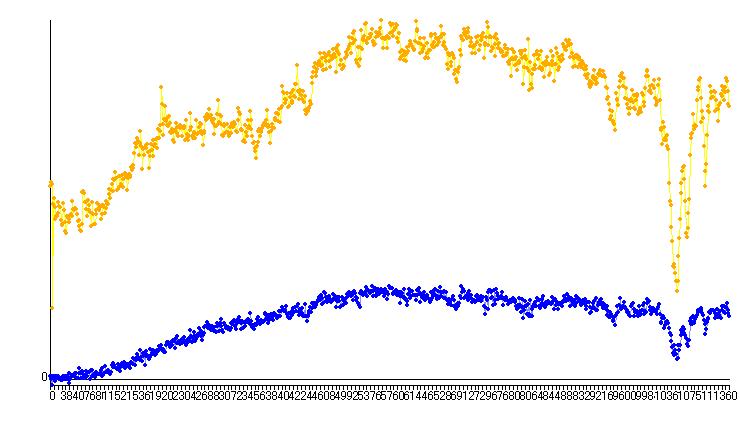
Observation the Eclipse of Iapetus
Kazuhisa Miyashita
May 13, 2007
Abstract
I and two persons, who are members of Tenpyo-no-Mori astronomical club,had observed Iapetus event. And I have analyzed recorded video tape using Limovie(Ver.0.9.25f beta). The Limovie program is test version which has a new feature called step measurement. The function is able to measure the frame at regular intervals. In case of this event, the effect of the diameter of the sun is larger than the effect of the diameter of the satellite. The density of the shadow changes gradually, because the diameter of the sun is refrected. Then, the measurement value are compared with the simulation of saturn's shadow.
The result of this analysis is as follows.
The appearance was begining : 11:57:41 +/-35sec(UTC)
The time of event central : 12:07:52 +/-35sec (UTC)
The apperrance was completed : 12:18:03 +/-35sec (UTC)
1. Observation
Date : May. 05 2007
Station : Tenpyo no mori, Akashina, Azumino-City, Nagano Pref., Japan.
Long.:137 54 44.61 E, Lat.:36 19 56.27 N, Hight:901.0m, Datum:JGD2000
Telescope : 25cm aperture, 250cm focul length, Schmidt Cassagrain
Camera : Tenmon guide TGV-M (=Watec WAT120N), Gain:Max, Exposure:128frame(is nearly 4sec)
Sony DCR TRV10
Timing Equipment : KIWI OSD
Video recording: From 11:57:28 to 13:27:20 (UTC)
Observer : Kazuhisa Miyashita, Shigeki Hayashi, Shoichi Ito (Tenpyo-no-mori Astronomical Club)
2. Advanced version of Limovie and Measurement this event
(1) Limovie beta version 0.9.25f for Long Event
The Limovie program is test version which has a new feature called STEPPING measurement. The function is able to measure the frame at regular intervals. You can use the feature simply set the interval in the edit area .
(2) Explanation about new feature
– The answer to question from Tony George -
The aim of this version is to measure the Iapetus event which has slow light change and during long time. When Mitsuru Soma introduced his prediction about Iapetus event, I wanted to observe and analyze this event. However there is an issue. This event is during 30 minutes or longer. Very long time is necessary to measure the AVI file. And the size of CSV file will be too large to analyze using MS-EXEL. EXEL has the limitation of 65536 records. However the 60 minute video has 108000 frames. Exel can not process such a big file. Then, I considered to solve this issue. I have two video cameras. One is WAT100N which is used for general occultation. And other is TGV-M same camera as WAT-120N. TGV-M(WAT120N) is possible the frame integration. It is used for faint star at asteroidal occultation... I will use the integration exposure for the long event. If switch is turned to integration, the camera outputs the same image during next integral exposure. In this case, Limovie will only have to measure one of these SAME frames. If the case of 128 integration (4 second exposure), the data obtained from 60 minutes length video is 844. This is same as 28 sec data of frame by frame measurement. And in the slow event such as Iapetus event, the accuracy of one second or less is not necessary. Then I decide make the feature called STEPPING measurement. I uploaded this trial version to provide the function to the person who want to analyze this Iapetus event. But I do not check the program enough yet. So it is as minor revision and trial version..
(3) New features and how to use
Stepping measure
Set the number of interval. Then, the measurement measure the frame at regular intervals.
Change the figure of background
1. Clich “Option” on the pulldown menu.
Then, “Measurement Option” window will be open.
2. Check the “Upper” or “Lower” or both, and close the “Measurement Option” window.
3. Change the “Width” in Form of BKG area.
Then the form of the background is changed to sector.
(4) Measurement of Iapetus event

Figure 1. Lightcurve of Iapetus(blue) and Tethys(Yellow)
from 11:57:28 to 13:00:10 (UTC)
This graph is improved data obtained using new function of fan like shape of background region. (See Figure 2.)
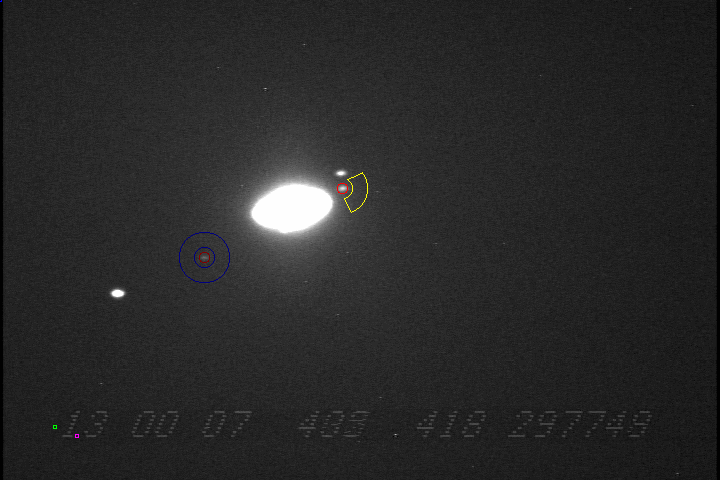
Figure 2. Measurement using Limovie
Tethys is also measured to estimate the effect of the absorption of light by haze.
To avoid the light of saturn and Rhea, the figure of background region was modefied using new function of Limovie.
Figure 1. is the luminous change of this event. The image of Iapetus was measured using Limovie. In spring of Japan, the haze thickens, and distant scenery comes to be hazed. The event time was just a such condision, and the sky was beginning cloudy. I prepared the measurement procedure to except the light absorption by haze as follows.
1. Tethys was also measured for comparison. And normalize the measurement of Iapetus using the value of Tethys.
2. The image
was captured by CCD video camera TGV-M (same model as WAT120N) with
128 frames integrate exposure.
It is enough in the accuracy of the
unit of one minute for the analysis of this event. And it can reduce
the noise of high frequency using the integrate exposure.
3. To obtain the detail of luminous change of Iapetus, the gain of the video camera was set high, to extent in which saturation was not caused.
The result of this analysis is shown in Figure 3. An irregular change by the atmosphere was excluded, and simple quantities of light change was appeared.
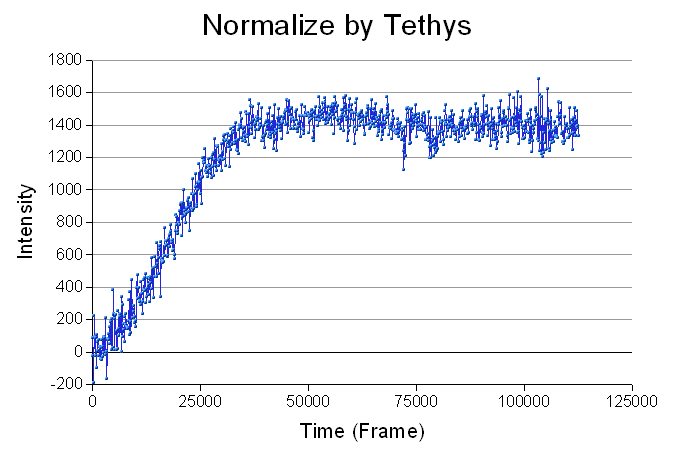
Figure 3. Normalized using Tethys as compared star
This is the result of normalize using Tethys to except the influence of thin cloud and haze.
3. Obtain the event time
The shadow of Saturn has gradual edge, because the solar has the size of disk. The graduate of the light is calculated as follows.
The radius of solar = 1
x : Geometric position of the satellite in the gradual shadow's edge. It is related with the geometric position of the sun viewing from Iapetus.
If the solar has flat face in brightness then the relational light intensity of the Iapetus is
I = x * sqrt(1-x^2) + arcsin(x) + pi/2
Spread sheet program (Openoffice.org, calc) was used for this simulation. The event central time and during time are assumed and the result of the calculation was compared with data of the brightness of 469 frames. These are processed using “Least Squares Fitting” and the event central time ,the event biggining time and the event completed time are obtained. The results are
The appearance was begining : No. 384 frame : 11:57:41 (UTC)
The time of event central : No.18688 frame : 12:07:52 (UTC)
The apperrance was completed : No. 36992 frame : 12:18:03 (UTC)
Figure 4. shows this comparation.
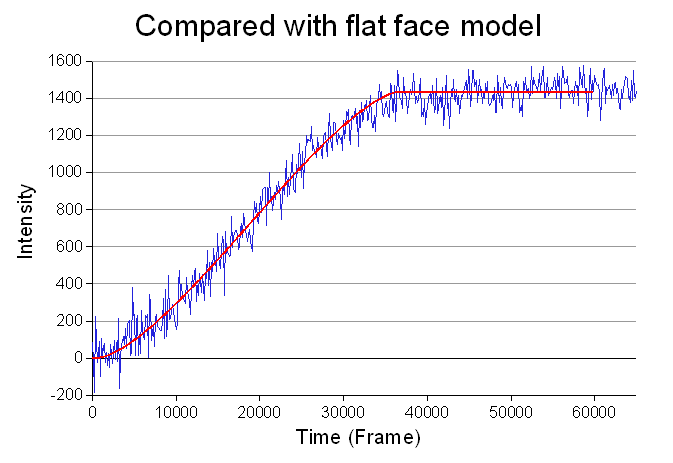
Figure 4. Light change is compared with the model assuming that the satellite is a uniform disk in brightness.
The “flat face model” is given the formula .....I = x * sqrt(1-x^2) + arcsin(x) + pi/2
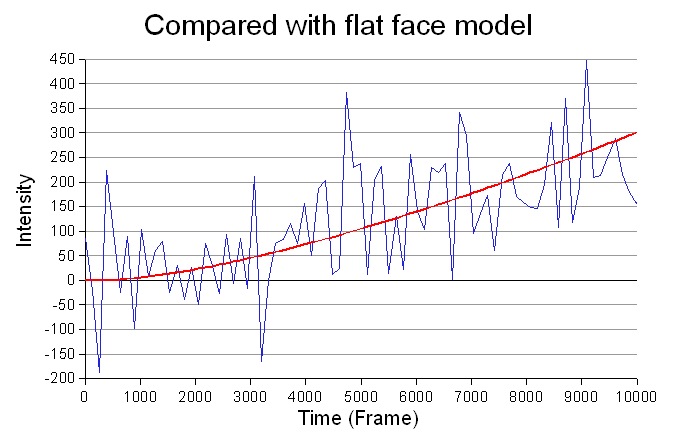
Figure 5. Light curve at the event beginning

Figure 6. The “star profile”
From Left, Sutarn, Tethys, Rhea
4. Luminous change seen in screen shot



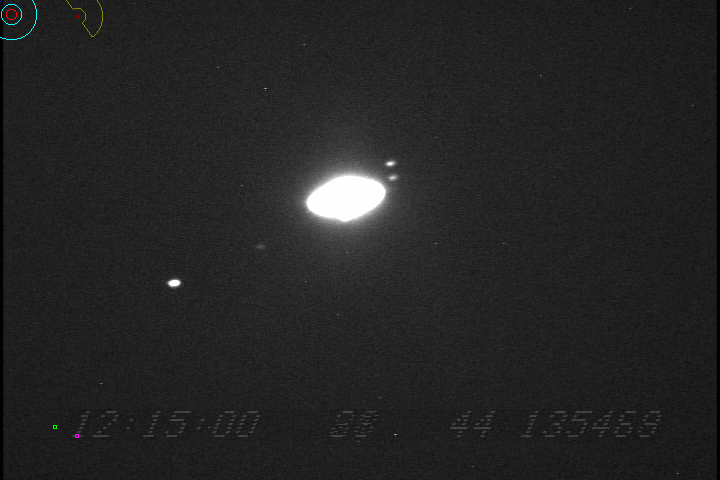

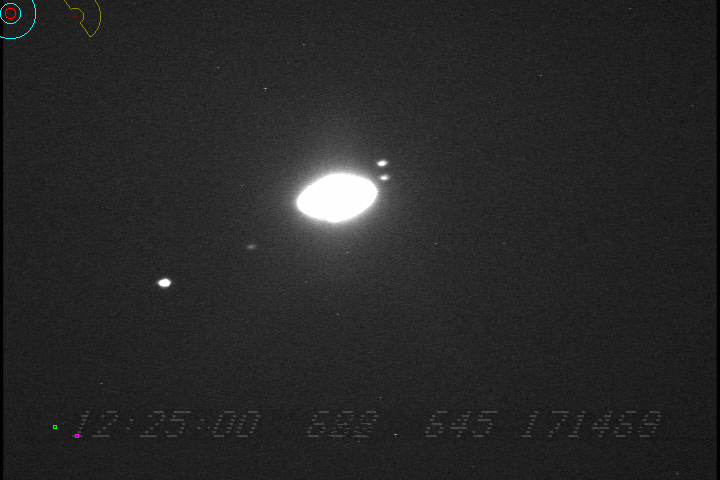


![]()